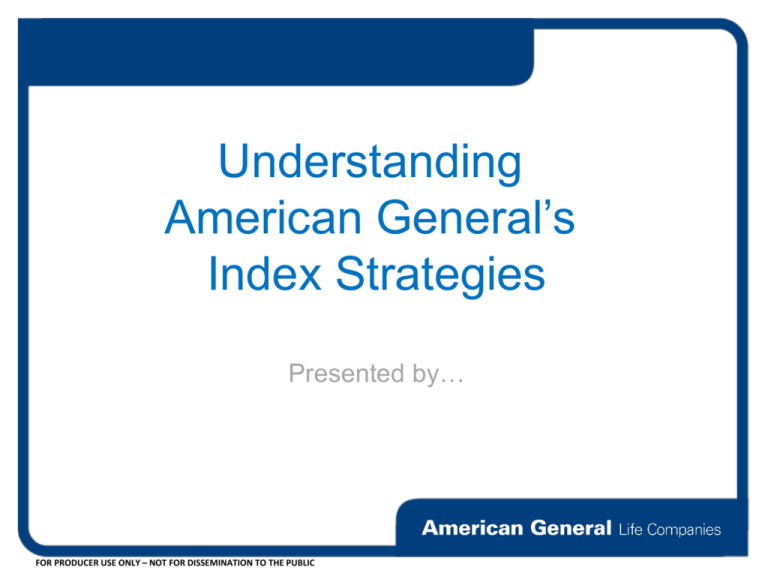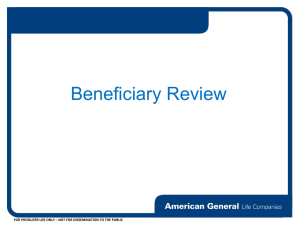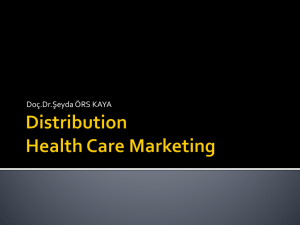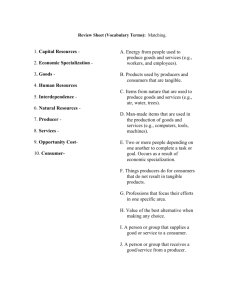
Understanding
American General’s
Index Strategies
Presented by…
FOR PRODUCER USE ONLY – NOT FOR DISSEMINATION TO THE PUBLIC
Agenda
Why do we use index strategies?
Options – Calls The Basics
Which Index?
1 Year Point-to-Point
5 Year Point-to-Point
The Power Of Hindsight Crediting
Which Strategy is Best?
FOR PRODUCER USE ONLY – NOT FOR DISSEMINATION TO THE PUBLIC
Why Does An
Insurance Carrier Use
Index Strategies?
FOR PRODUCER USE ONLY – NOT FOR DISSEMINATION TO THE PUBLIC
It’s All About Matching Liabilities
2
Policy Premium
3
Net Premium
American
General
Indexed
Fixed UL
UL
7
Indexed Credit
Crediting
Index
Rate
1 Credit
Liability
Liability
4
Guaranteed Floor
8
Liability
Hedging
Costs
Crediting
Participation
Rate
Limits
6
Indexed Liability
Budget
AG’s
General
Account
5
Hedging Budget
Investment
Assets
Assets
Do NotMatch
MatchLiability
Liability
Bank
Assets
Match
Liabilities
FOR PRODUCER USE ONLY – NOT FOR DISSEMINATION TO THE PUBLIC
What Do We Use To Hedge?
Definition of 'Call Option'
An agreement that gives an investor the
right (but not the obligation) to buy a stock,
bond, commodity, or other instrument at a
specified price within a specific time
period.
Source: www.investopedia.com
FOR PRODUCER USE ONLY – NOT FOR DISSEMINATION TO THE PUBLIC
Understanding A Call Option
Source: http://binaryoptionbeginner.com
FOR PRODUCER USE ONLY – NOT FOR DISSEMINATION TO THE PUBLIC
Bullish or Bearish?
FOR PRODUCER USE ONLY – NOT FOR DISSEMINATION TO THE PUBLIC
IUL is Bullish!
What % of the years in any of the decades since
the Great Depression has the S&P increased in value?
There were 8 decades since the Great Depression
1930s:
40% of the years (Great Depression Decade)
1940s:
70% of the years (World War 2 Decade)
1950s:
80% of the years
1960s:
70% of the years
1970s:
70% of the years (High inflation/interest rates)
1980s:
90% of the years
1990s:
90% of the years
2000s:
60% of the years (Dot Com, 9/11 and the Great Recession)
FOR PRODUCER USE ONLY – NOT FOR DISSEMINATION TO THE PUBLIC
What Is An Index?
A hypothetical group of securities, typically
representing a particular market or sector
The securities in an index are weighted and
measure changes within a particular financial
market
AG uses “Price Indices” which exclude dividends
“Total Return Indices” include dividends
FOR PRODUCER USE ONLY – NOT FOR DISSEMINATION TO THE PUBLIC
What Index To Use?
Russell 2000
S&P 500
Barclays
S&P 400
Dow Jones Industrial
Hang Seng
Average
Euro Stoxx 50
MSCI AEFE
NASDAQ
Dow Jones World
FOR PRODUCER USE ONLY – NOT FOR DISSEMINATION TO THE PUBLIC
Index Usage Breakdown
3First-year
premium allocations
FOR PRODUCER USE ONLY – NOT FOR DISSEMINATION TO THE PUBLIC
IUL Terminology
INDEX
The benchmark used for measurement to
determine interest to be credited to the policy
What indices does American General use?
FOR PRODUCER USE ONLY – NOT FOR DISSEMINATION TO THE PUBLIC
S&P 500
An index of 500 stocks chosen for market size, liquidity
and industry grouping, among other factors. The S&P 500
is designed to be a leading indicator of U.S. equities and
is meant to reflect the risk/return characteristics of the
large cap universe.
FOR PRODUCER USE ONLY – NOT FOR DISSEMINATION TO THE PUBLIC
Dow Jones EURO STOXX 50
The EURO STOXX 50 Index, Europe's leading Blue-chip index for the
Eurozone, provides a Blue-chip representation of supersector leaders
in the Eurozone. The index covers 50 stocks from 12 Eurozone
countries: Austria, Belgium, Finland, France, Germany, Greece,
Ireland, Italy, Luxembourg, the Netherlands, Portugal and Spain. The
EURO STOXX 50 Index is licensed to financial institutions to serve as
underlying for a wide range of investment products such as Exchange
Traded Funds (ETF), Futures and Options, and structured products
worldwide.
FOR PRODUCER USE ONLY – NOT FOR DISSEMINATION TO THE PUBLIC
Hang Seng
A market capitalization-weighted index of 40 of the largest
companies that trade on the Hong Kong Exchange. The Hang Seng
Index is maintained by a subsidiary of Hang Seng Bank, and has
been published since 1969. The index aims to capture the leadership
of the Hong Kong exchange, and covers approximately 65% of its
total market capitalization. The Hang Seng members are also
classified into one of four sub-indexes based on the main lines of
business including commerce and industry, finance, utilities and
properties.
FOR PRODUCER USE ONLY – NOT FOR DISSEMINATION TO THE PUBLIC
So Many Crediting Strategies…
3-YearTerm End Point
1-Year Point-to-Point
2-Year Point-to-Point
Monthly Averaging
FOR PRODUCER USE ONLY – NOT FOR DISSEMINATION TO THE PUBLIC
High Water Mark
Monthly Point-to-Point
Multiple Index
5-Year Point-to-Point
Biennial Term End Point
What makes up the crediting
methodology?
It is based on combining three moving parts:
1. The equity index or indices used
2. Index term method and
3. Either a cap rate or a participation rate
FOR PRODUCER USE ONLY – NOT FOR DISSEMINATION TO THE PUBLIC
Index Interest Crediting Methods
Whenever the index is above the floor, an account will be
credited by either one of two methods:
CAP RATE: The index interest rate up to a specified limit (the
‘cap’), such as 12% that can be applied to the policy.
PARTICIPATION RATE: A specified percentage (the
participation) of the index’s increase used in crediting interest to
the policy, (e.g., 60%).
For BOTH Methods: The account will never be credited
with less than the guaranteed ‘floor’ rate, typically between
0 - 2%, regardless of the performance of the index.
FOR PRODUCER USE ONLY – NOT FOR DISSEMINATION TO THE PUBLIC
Which One Is Better Cap
or Participation Rate?
Cap Rate 12%
Participation Rate 60%
=
20% Breakeven Point
FOR PRODUCER USE ONLY – NOT FOR DISSEMINATION TO THE PUBLIC
1 Year Point-to-Point
Just
Measuring
The Difference
Between Two
Points In Time
Source: http://finance.yahoo.com
FOR PRODUCER USE ONLY – NOT FOR DISSEMINATION TO THE PUBLIC
Point-to-Point - Cap
Example: Assume a cap of 10%
(participation rate of 100%) and a
guarantee of 1%:
If the index increases 8%, policy
credited 8% (100% x 8%)
If the index increases 20%, policy
credited 10% (100% x 10%)
If the index increases 0%, policy
credited 1% (guarantee rate)
If the index decreases 10%, policy
credited 1% (guarantee rate)
FOR PRODUCER USE ONLY – NOT FOR DISSEMINATION TO THE PUBLIC
Point to Point: the period of
time over which the index is
being measured.
• Each index term has a
beginning date and an
ending date.
Point-to-Point - Participation
Example: Assuming no cap, a
participation rate of 60% and a guarantee
of 2%:
If the index increases 10% policy
credited 6% (60% x 10%)
If the index increases 50%, policy
credited 30% (60% x 50%)
If the index increases 0%, policy
credited 2% (guarantee rate)
If the index decreases 10%, policy
credited 2% (guarantee rate)
FOR PRODUCER USE ONLY – NOT FOR DISSEMINATION TO THE PUBLIC
Participation: the percentage
of positive index movement
which will be used in the
crediting calculation
• Acts as one factor in
determining a ceiling on
crediting rate of the policy
5 Year Point-to-Point Participation
S&P 500
5 Year Point-to-Point
Change = 60%
60% x 25% = 15%
15%
+
Adjusted Index Return
EURO STOXX
5 Year Point-to-Point
Change = -28%
=
105%
X
60%
=
Participation Rate
+
Hang Seng
5 Year Point-to-Point
Change = 120%
120% x 75% = 90%
FOR PRODUCER USE ONLY – NOT FOR DISSEMINATION TO THE PUBLIC
90%
=
63%
Index Return
Overweighting Option vs.
Equal Weighting
Example
Weighting %
Indices
01/01/07
12/31/11
Performance
Index A
1,507.65
4,849.22
221.64%
75 50 33.33
Index B
620.73
1,455.22
134.44%
25 30 33.33
Index C
10,722.76
16,102.35
50.17%
0 20 33.33
Hindsight Option Growth
(75/25/0 weighting)
Weighted Option Growth
(50/30/20 weighting)
Weighted
Approach
Equal Weight Option Growth
(33.33% per index)
Equal
Weighting
Overweighting Outperforms
This example does not take into consideration option costs, participation
rates, insurance loads, and other factors that would affect the actual
results within a life insurance policy.
FOR PRODUCER USE ONLY – NOT FOR DISSEMINATION TO THE PUBLIC
199.84
Overweighting
Approach
5 Yr
Period
161.18
135.40
38.67%
64.44%
Elite Index
Elite Index
Rate
Declared Interest Account
3.00%
Minimum Guarantee
3.00%
Cap Rate Index Account
Cap Rate
10.75%
Illustrated Rate
6.96%
Minimum Guarantee
1.00%
Participation Rate Index Account
Participation Rate
60%
Illustrated Rate
7.60%
Minimum Guarantee
2.00%
Rates Current as of 04/10/2013
FOR PRODUCER USE ONLY – NOT FOR DISSEMINATION TO THE PUBLIC
AG Choice Index GUL®
AG Choice Index GUL®
Rate
Declared Interest Account
3.20%
Minimum Guarantee
2.00%
1-Year Cap Rate Index Account
Cap Rate
11.50%
Illustrated Rate
7.30%
Minimum Guarantee
1.00%
5-Year Participation Rate Index
Account
Participation Rate
65%
Illustrated Rate
9.48%
Minimum Guarantee
1.00%
Rates Current as of 04/10/2013
FOR PRODUCER USE ONLY – NOT FOR DISSEMINATION TO THE PUBLIC
Elite Global Plus® II
Elite Global Plus® II
Rate
Declared Interest Account
3.00%
Minimum Guarantee
2.00%
5-Year Index Account
Participation Rate
65%
Illustrated Rate
9.28%
Minimum Guarantee
0.00%
1-Year Index Account
Cap Rate
10.75%
Illustrated Rate
6.76%
Minimum Guarantee
0.25%
Rates Current as of 04/10/2013
FOR PRODUCER USE ONLY – NOT FOR DISSEMINATION TO THE PUBLIC
Which Strategy is Best
in the Long Term?
FOR PRODUCER USE ONLY – NOT FOR DISSEMINATION TO THE PUBLIC
Which Strategy?
The best strategy is the one that is most aligned with the client’s
opportunity cost & risk tolerance preferences
Companies primarily focus on the historical performance of a
strategy using the current cap (or spread or participation)
We know these index parameters can and will change over time
What may not be clear is that some strategies have to change
more than others when market conditions change.
FOR PRODUCER USE ONLY – NOT FOR DISSEMINATION TO THE PUBLIC
Questions
FOR PRODUCER USE ONLY – NOT FOR DISSEMINATION TO THE PUBLIC
Policies issued by:
American General Life Insurance Company (AGL)
2727-A Allen Parkway, Houston, TX 77019
Issued by American General Life Insurance Company (AGL)
Policy Form No. 11474, Policy Form No. 08444, Policy Form No. 08326
The underwriting risks, financial and contractual obligations and support functions
associated with the products issued by AGL are its responsibility. Guarantees are
subject to the claims-paying ability of the issuing insurance company. AGL does not
solicit business in the state of New York. Policies and riders not available in all states.
American General Life Companies, www.americangeneral.com, is the marketing
name for a group of affiliated domestic life insurers, including AGL. Prior to soliciting
business, be certain that you are appropriately licensed and appointed with the
insurer and that the product has been approved for sale by the insurer in that state. If
uncertain, please contact your American General Life Companies representative for
assistance. Important: Do not state or imply that the purchase of an index universal
life product is an investment or a means of participating in “securities,” “markets,”
“stocks,” or “stock market index.”
AGLC106914
©2013. All rights reserved.
FOR PRODUCER USE ONLY – NOT FOR DISSEMINATION TO THE PUBLIC







